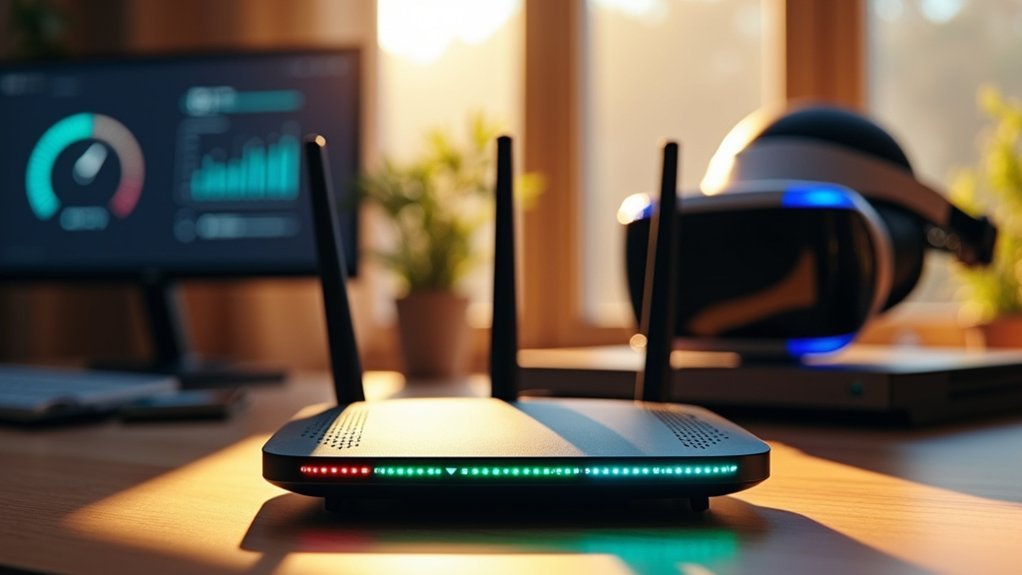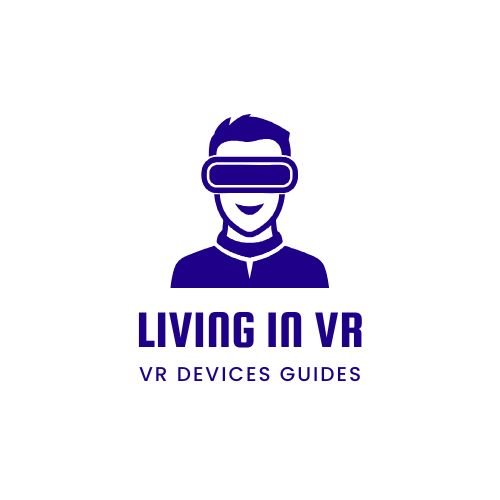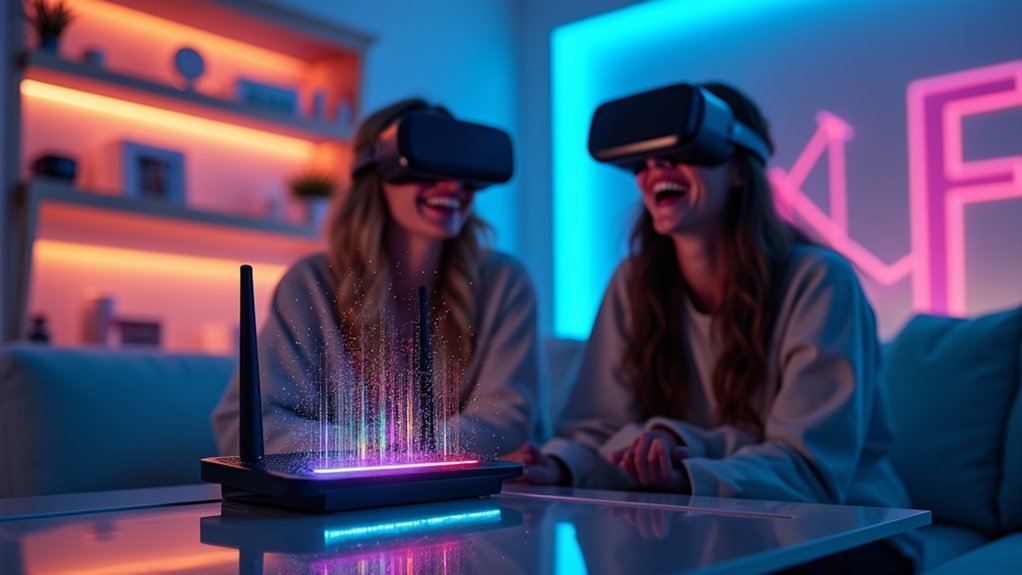You’ll need a minimum of 25 Mbps upload speed for VR social platforms to prevent lag during virtual conversations and avatar interactions. For ideal performance, aim for 50+ Mbps upload speeds, while download speeds should stay around 50 Mbps. If you’re multitasking with video streaming or running multiple VR headsets simultaneously, you’ll require at least 100-200 Mbps total bandwidth. Symmetrical fiber connections work best since they provide matching upload and download speeds for seamless real-time communication and instant feedback during social interactions.
Understanding VR Social Platform Bandwidth Demands

When you’re diving into VR social platforms, you’ll quickly discover that these immersive experiences demand considerably more bandwidth than traditional online activities.
You’ll need a minimum upload speed of 25 Mbps to prevent lag and maintain smooth interactions with other users. However, VR social applications perform best with 50 Mbps or higher for ideal resolution and responsiveness.
For optimal VR social experiences, aim for 50 Mbps upload speeds rather than settling for the 25 Mbps minimum requirement.
If you’re multitasking with bandwidth-heavy tasks like video streaming, you’ll require at least 100 Mbps total internet speed. High-quality streaming becomes essential for preventing motion sickness and maintaining immersion.
You’ll benefit most from symmetrical bandwidth, where your upload speeds match download speeds. This balance guarantees seamless communication and real-time interaction in virtual environments, creating the responsive experience that makes VR social platforms truly engaging.
Upload Vs Download Speed Requirements for Virtual Reality
Although most internet users focus primarily on download speeds, VR social platforms actually place greater emphasis on your upload capabilities.
While download speeds of 50 Mbps handle high-resolution graphics and immersive environments adequately, upload speeds create the real bottleneck for real-time communication.
Your bandwidth requirements differ considerably between basic and advanced VR experiences:
- Standard VR social platforms need 25 Mbps upload speeds for smooth interactions
- Competitive or cloud-based VR demands 200+ Mbps upload speeds for ideal performance
- Download speeds remain relatively stable at 50 Mbps across most applications
Symmetrical bandwidth becomes essential because insufficient upload speeds cause network congestion, resulting in choppy video and delayed responses.
You’ll experience seamless interactions when your upload and download speeds match, ensuring instant feedback during virtual conversations.
Fiber Optic Internet: The Gold Standard for VR Experiences

When you’re exploring VR social platforms, fiber optic internet delivers the symmetrical upload and download speeds that copper connections simply can’t match.
You’ll experience dramatically reduced latency that prevents the lag and buffering issues that cause simulator sickness and ruin immersive interactions.
With fiber’s consistent gigabit speeds reaching 1 Gbps or higher, you’re equipped to handle the demanding 200 Mbps requirements that competitive multiplayer and high-quality VR streaming demand.
Symmetrical Bandwidth Advantages
While most internet connections prioritize download speeds over uploads, VR social experiences demand something entirely different: perfectly balanced bandwidth that flows equally in both directions.
Symmetrical bandwidth guarantees your upload and download speeds match perfectly, eliminating the latency issues that plague traditional connections during intensive video streaming sessions.
Fiber optic internet delivers this essential balance, providing consistent performance whether you’re transmitting your avatar’s movements or receiving complex virtual environments.
This high-speed internet capability becomes vital when multiple users interact simultaneously in shared VR spaces.
- Real-time synchronization: Equal upload/download speeds keep all participants perfectly synchronized during collaborative VR activities
- Reduced network congestion: Balanced bandwidth prevents bottlenecks that cause stuttering or disconnections
- Enhanced social interaction: Seamless data flow enables natural conversations and gestures without communication delays
Low Latency Benefits
Because VR social platforms rely on split-second timing between your movements and visual feedback, even microseconds of delay can shatter the illusion of presence and leave you feeling nauseous.
Low latency becomes your lifeline for maintaining immersion during social interactions.
Fiber optic connections deliver the sub-20 millisecond response times essential for seamless experience in virtual environments.
When you’re streaming high-quality VR content, those upload speeds of 100+ Mbps prevent the cue conflicts that trigger simulator sickness.
Unlike traditional broadband that buckles under pressure, gigabit fiber eliminates network congestion completely.
You’ll notice the difference immediately—your avatar responds instantly to gestures, conversations flow naturally, and visual fidelity remains crisp throughout extended sessions.
This technological foundation transforms VR social platforms from laggy experiments into genuine digital meeting spaces.
Managing Multiple VR Users on Shared Networks
When you’re setting up VR for multiple users in your home, you’ll need to calculate bandwidth requirements carefully since each headset demands at least 25 Mbps for smooth gameplay.
Your network will face congestion challenges as simultaneous VR sessions compete for available bandwidth, potentially causing lag and performance issues that can trigger motion sickness.
You can optimize your router’s configuration to prioritize VR traffic and manage these demands effectively, ensuring everyone gets the seamless experience they expect.
Bandwidth Requirements Per User
Although a single VR user might get by with basic broadband speeds, managing multiple VR users on a shared network demands considerably more bandwidth to maintain everyone’s immersive experience.
Each VR headset requires substantial upload speed—around 25-50 Mbps per user for ideal streaming performance. When multiple devices compete for connection resources, you’ll need to scale your network capacity accordingly.
For households with several VR users, consider these bandwidth requirements:
- Single User: 50 Mbps for standalone VR headsets like Meta Quest 2
- Multiple Users: 100-200 Mbps total connection to support simultaneous VR gaming and 4K streaming
- PC VR Streaming: Minimum 100 Mbps per user for smooth operation
Prioritizing symmetrical bandwidth guarantees your upload speeds match download speeds, greatly improving overall network performance across multiple devices during intensive VR social sessions.
Network Congestion Management
Having adequate bandwidth represents only half the battle—you must actively manage how that bandwidth gets distributed across your network.
Network congestion severely impacts VR performance, causing increased latency and reduced frame rates in multi-user environments. You’ll need at least 200 Mbps to effectively support multiple VR users alongside streaming and video calls.
Configure Quality of Service settings on your router to prioritize VR traffic over less critical applications. This guarantees your headsets receive the bandwidth they need when demand peaks.
Consider establishing wired connections for VR systems whenever possible, as Ethernet delivers more stable performance than Wi-Fi.
Make monitoring internet speeds a regular practice. Track your network’s performance during peak usage times and adjust settings accordingly to maintain ideal VR experiences for all users.
Router Configuration Optimization
Since multiple VR users can quickly overwhelm a standard router setup, you’ll need to optimize your router configuration to handle the demanding bandwidth requirements.
Start by enabling Quality of Service (QoS) settings to prioritize VR applications, ensuring low latency during peak usage. Your internet speed should reach at least 200 Mbps for multiple simultaneous users.
- Prioritize wired connections: Use Ethernet connections for VR devices whenever possible, as they deliver more stable speeds and reduced latency compared to Wi-Fi.
- Keep firmware current: Regularly update your router’s firmware to access the latest performance optimizations and security improvements for VR traffic management.
- Expand coverage strategically: Consider investing in a Wi-Fi mesh system to eliminate dead zones and provide consistent bandwidth throughout your home.
How Network Latency Affects Social VR Interactions
When you’re chatting with friends in a virtual world, network latency determines whether your conversation flows naturally or becomes an awkward mess of delayed responses and jerky movements. Your internet speed directly impacts social VR performance, with low latency below 20 milliseconds being crucial for seamless interactions.
High bandwidth of at least 50 Mbps supports real-time communication and prevents avatar synchronization issues.
When network latency exceeds 100 milliseconds, you’ll notice sluggish responses that can trigger motion sickness and destroy immersion. Multiple participants increase demands on your connection, making network congestion a significant concern.
Your user experience suffers when delayed voice communication creates disjointed conversations, breaking the sense of presence that makes social VR compelling. Symmetrical bandwidth guarantees consistent performance across all users.
Optimizing Router Settings for Seamless VR Performance

While your internet speed forms the foundation of VR performance, your router’s configuration can make or break your social VR experience. Optimizing your setup involves several essential adjustments that directly impact reducing latency and maintaining stable connections during immersive VR sessions.
Start by configuring QoS settings to prioritize VR traffic, ensuring your headset gets bandwidth preference over other devices. Switch from wireless connections to wired Ethernet whenever possible—this single change dramatically improves stability and reduces lag. Gaming routers offer additional benefits like DDoS protection during competitive sessions.
Prioritizing VR traffic through QoS settings and switching to wired Ethernet connections delivers the stable, low-latency performance essential for immersive experiences.
- Adjust your wireless channel to minimize interference from neighboring networks
- Keep your router’s firmware updated for enhanced performance and security features
- Enable dedicated gaming modes that optimize traffic flow for real-time applications
These adjustments transform frustrating lag into smooth social interactions.
VR Headset-Specific Network Requirements and Comparisons
Router optimization sets the stage, but each VR headset brings unique network demands that directly affect your social experiences. Your Meta Quest 2 needs minimum 25 Mbps for standalone gaming, while streaming PC VR content requires 100 Mbps for smooth performance. The Meta Quest 3 demands higher internet speeds—ideally 200 Mbps—to support advanced features and high-quality videos during social interactions.
| VR Headset | Minimum Speed | Best Performance |
|---|---|---|
| Meta Quest 2 | 25 Mbps | 50+ Mbps |
| Meta Quest 3 | 50 Mbps | 200 Mbps |
| PC-Based VR | 50 Mbps | 100+ Mbps |
Understanding these VR headset-specific requirements helps you prioritize network optimization. Multiple users engaging simultaneously need 200 Mbps or higher to prevent degradation during social experiences.
Future-Proofing Your Connection for Next-Generation VR Social
How can you guarantee your network stays ahead of rapidly advancing VR social technology?
You’ll need at least 200 Mbps upload speed for seamless VR social experiences. Symmetrical bandwidth from fiber optic connections guarantees consistent performance during multiplayer sessions.
Multiple users require 500 Mbps or higher to prevent network congestion.
Cloud-based VR services will demand even higher internet speeds, making upgrades to WiFi 6E or WiFi 7 essential. You can’t afford to fall behind as technology evolves.
Key strategies for future-proofing include:
- Invest in symmetrical fiber optic connections for equal upload and download speeds
- Upgrade to WiFi 6E technology to handle increasing data demands
- Plan for 500+ Mbps bandwidth in multi-user households
Regularly monitoring internet speed and optimizing router settings maintains reliability for smooth interactions.
Frequently Asked Questions
What Internet Speed Do I Need for VR?
You’ll need at least 25 Mbps for basic VR gaming, but 50 Mbps is recommended for smooth performance. For streaming PC VR or multiplayer experiences, you’ll want 100-200 Mbps or higher speeds.
How Many Mbps Does VRCHAT Use?
You’ll need 25 Mbps minimum for VRChat’s basic functionality, though 50 Mbps provides smoother performance. For ideal multiplayer experiences, you should aim for 100 Mbps or higher to handle data-heavy interactions.
Is 100MBPS Enough for VR?
You’ll find 100 Mbps adequate for single-user VR experiences like VRChat and PC streaming via Air Link. However, you’ll need higher speeds for competitive multiplayer gaming or households with multiple VR users.
Is 500 Mbps Good for VR?
Yes, 500 Mbps is excellent for VR. You’ll experience smooth, high-quality gaming without lag. This speed easily handles multiple VR users simultaneously and supports advanced features like real-time streaming and content sharing effortlessly.





Leave a Reply